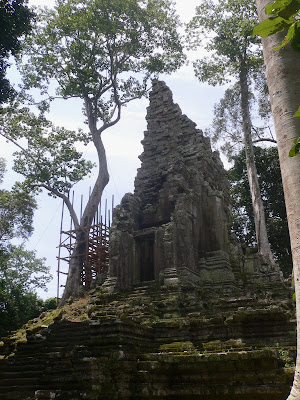Cambodians love a public holiday and who are we to disagree. For the Pchum Ben 3-day holiday in October, we decided that it really was about time that we visited what is truly one of the great wonders of the ancient world: Angkor Wat. So we hopped on a bus to Siem Reap, put on our walking sandals, hired a guide (whose knowledge of and delight in Khmer culture and history were simply wonderful) and sallied forth.
Actually, referring to Angkor Wat is a bit of a misnomer. There are actually hundreds of ruins in a great many complexes spread out over many kilometres; Angkor Wat is just one of them. And throughout them all, you will encounter majesty wherever you turn.
Actually, referring to Angkor Wat is a bit of a misnomer. There are actually hundreds of ruins in a great many complexes spread out over many kilometres; Angkor Wat is just one of them. And throughout them all, you will encounter majesty wherever you turn.

Most people have heard of Angkor but nothing prepares you for the size and scale of the ancient buildings and monuments in the area. The Angkor civilisation built an extraordinary series of buildings from about the 12th to the 15th century, many of which have survived largely intact despite centuries of intervening neglect and return to the jungle. Below is the Bayon temple, one of the highlight of the Angkor Thom complex: a walled and moated city of over 3 square kilometres.

The Angkor civilisation transitioned from Hinduism to Buddhism during the course of its existence, and the Hindu influence can be seen very clearly throughout the architecture. Carved stone faces of gods and demons appear everywhere and in all sizes from the immense to the miniature. On most of the temples, all of the walls are covered in intricate carvings, while the turrets and towers are host to gigantic watching faces.

Each block in the face below is about a metre square. The sheer physical effort that must have been involved in its construction - in about the 14th Century - is mind-boggling. Added to that, all the stone came from quarries over a hundred kilometres away and was brought through the jungle to the site. Shows what you can do when you put your mind to it!

In all, there are many kilometres of beautifully carved walls, most of which are wonderfully preserved and show scenes of Cambodian life from over 500 years ago - some of which are remarkably similar to scenes of Cambodian life today.

They also show great events from Cambodian history and from Hindu mythology.

Our guide Lypeng's hand gives you some idea of the scale and the amazing intricacy of the carving. Renaissance Italy, eat your heart out!

This fellow reminds us of someone. Suggestions on a postcard...
Not all of the temples are particularly big, and not all of them were built by people with T-squares and straight edges. But they all have the most extraordinary feeling of antiquity and majesty, even when you're not quite sure whether the builders really meant them like that or whether overconsumption of Cambodia's beloved Angkor beer actually dates back 800 years to the Angkor period. Actually, we've had one or two cans that taste like there might be something in that theory.

One temple has a particular eerie majesty of its very own. Ta Prohm is not particularly large or spectacular (although it is reputed to have once had a tower with over 1,000 diamonds in, the recesses for which you can still see today). It is, however, the temple that has become the most at one with the jungle. Pictures can not begin to do it justice, but we'll show you a couple anyway.

To give you some idea of the scale, that's a 6 foot 1, 220 pound barang in among the tree roots in the picture below. For those of you reading this in metric, that's 186 cm and 100 kg. Lypeng stands well clear on the right (perhaps he's read the bit about Old Man Willow in The Lord of The Rings).

And now on to the most famous of them all: Angkor Wat itself. You approach it across an artificial, perfectly rectangular lake that goes right around the complex and makes the lakes in every western park we've ever seen look like garden ponds.

After you pass through the outer portico, you're not even nearly there. You then follow an elevated stone causeway for about a kilometre to the main temple building with its five beehive towers. The building is square and each side is 1 kilometre long: now work out the size of the lake!

Every available surface is covered in carvings. There are over 1,000 of these dancing girls (called Apsaras in Khmer) but this one, hidden around a corner that you have to lean out madly over a 5 metre drop in order to see, is the only one that is smiling. The motivation of the artist is a mistery, but I think I would have liked him.

Inside the main temple, the sheer scale is breahtaking.

And there are surprises around every corner.

All too soon, the sun started to come down and we had to leave, despite hardly having scratched the surface. We'll be going back.

The classic view: Angkor Wat in the jungle clearing (and if anyone out there can tell us how to photoshop out the scaffolding that seems to follow us around the most beautiful spots on the planet, we'd love to hear from you).
More soon. In the meantime, please don't forget the need to keep supporting VSO through our Justgiving page at www.justgiving.com/jagoteers.




No comments:
Post a Comment